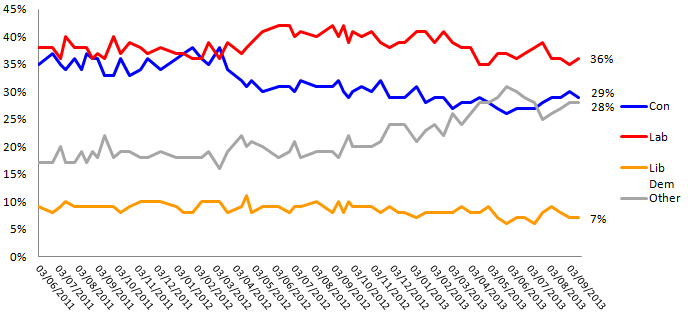Political Polling – 17th September 2013
17th September 2013
Labour’s lead expands slightly to seven points as Ed Miliband’s party rises to 36% while the Conservatives drop to 29%.
No change for UKIP or the Lib Dems as they remain on 17% and 7% respectively.


| † | % | Change |
| Conservative | 29 | -1 |
| Labour | 36 | +1 |
| Liberal Democrats | 7 | n/c |
| Other parties | 28 | n/c |
Other Parties (breakdown)
| † | % | Change |
| UKIP | 17 | n/c |
| Green | 4 | n/c |
| SNP | 3 | -1 |
| BNP | 1 | -1 |
| Plaid Cymru | 1 | +1 |
| Other | 1 | n/c |
Approval ratings
- David Cameron’s approval rating has dropped slightly to 33% while 50% disapprove giving him a net rating of -17%
- Ed Miliband has seen a similarly sized improvement with his net rating rising to -29% from -31%. 21% approve of the Labour leader while 50% disapprove
- While his party may not have seen much of a post-conference bounce, Lib Dem leader Nick Clegg has seen a slight jump in his approval rating to 16% (up from 13%) while 58% disapprove. This takes his net rating to -42%, an improvement on the -47% he registered last time
| † | % Approve | % Disapprove | Net rating | Net rating (own party) |
| David Cameron | 33% | 50% | -17% | +81% |
| Ed Miliband | 21% | 50% | -29% | +31% |
| Nick Clegg | 16% | 58% | -42% | +47% |
Opinium Research carried out an online survey of 1,929 GB adults aged 18+ from 17th to 19th September 2013. Results have been weighted to nationally representative criteria.
Interview Method and Sample
This survey is conducted online by CAWI (computer aided web interviewing), using Opinium?s online research panel of circa 30,000 individuals. This research is run from a representative sample of GB adults (aged 18+ in England, Scotland and Wales). The sample is defined from pre-collected registration data containing gender, age (18-34, 35-54, and 55+), region (North East, North West, Yorkshire and Humberside, East Midlands, West Midlands, East of England, London, South East, South West, Wales, and Scotland), working status and social grade to match the latest published ONS figures.
Opinium also takes into account differential response rates from the different demographic groups, to ensure the sample is representative.


